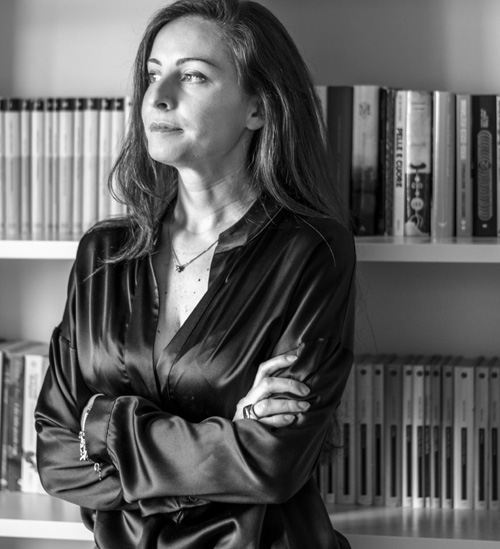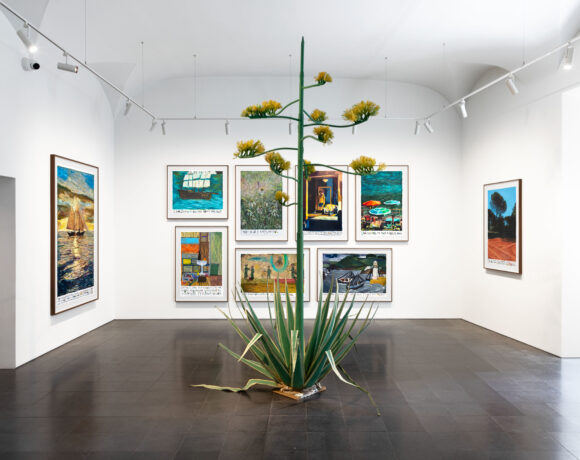The artist’s studio is a place of intimate research and experimentation, a field of forces where fresh visions are captured through new techniques, allowing for progress with an uncertain order of probability, since many of these techniques will never be used, while others will be further explored. The goal of every artist has always been to create a coexisting balance between the workspaces and the tools dedicated to their research, where verification and practice represent the nocturnal premise for bringing an artwork to light. What happens in the studio opens new paths, thereby leading to new encounters, which are signs of a syncretic approach with the physical elements of the space, such as light, objects, and books. These are work tools that interact not for an end but for a relationship: a gap in which each element is recognized for what truly belongs to us.

Giulio Catelli and Luca Grechi, “Giulio e Luca”, 2024, pencil on paper, 21 x 29.7 cm, courtesy Galleria Richter Fine Art, Rome
In this double studio visit, the protagonists are Giulio Catelli and Luca Grechi: although their research is at opposite ends, they converge on painting as their main means of expression. Catelli focuses on composition painted ‘en plein air’, while Grechi emphasizes the rendering of tonal sensations, always respecting the execution time. However, despite these evident differences, drawing practice is fundamental for both, expressed in sketchbook, diaries, or in loose sketches gathered in worn folders. Thus, considering painting as a state of being, a discovery of self, everything generated by drawing reveals itself as a natural necessity, even more so than painting, experienced with a mix of wonder and clarity, as it tends to enhance, extend and deepen analytical digressions. In the following questions, the intention is to highlight the common practice of visual notes as an essential tool, no less important than the abandonment of the use of the easel, thereby profoundly altering the relationship with the search for subject matter, spatial delimitation and the organization of the work.

Giulio Catelli, “Albero e paesaggio”, 2024, china on paper, 29,5 x 42 cm, courtesy Galleria Richter Fine Art, Rome
Catelli paints outdoors with subjects drawn from life, so it is worth asking what the studio becomes for the artist, if not a place of archiving and contemplation, where the writing of diaries has always accompanied his activity. Indeed, the artist prefers to jot down notes on loose sheets and conversely uses writing along with the occasional diary sketch as a fundamental tool for self-reflection, to remember his painting activities and intimate memories, to record a thought in full gestation, as well as impulsive and turbulent accounts. For Catelli, the diary is an autonomous document, serving as an inflexible and severe self-restitution, ultimately becoming a useful and fundamental tool capable of verifying the progress of his works, whether stalled or inadvertently compromised by easy solutions. Conversely, drawing is the sincerest outcome of his painting, not necessarily preparatory to a work but revealing the study of the subject’s nature and its composition. In other words, it is the observation of a place or situation, where living things rises: sketching the subject with pen and ink at maximum speed, never compromising the readability of the drawing, allowing an explosive and irregular, fragmented yet immediate writing to emerge, ready to capture fresh and bare life.

Luca Grechi, “Taccuino”, 2016, blue bic pen on paper
For Grechi, it is not the diary that accompanies his research activity, but rather the sketchbook, where visual notes mostly coexist with sporadic writings, reflecting a mind that freely follows the creative urgency to create images at any moment. The artist takes note of what is ordinary, keeping himself in practice with any object, whether rough, worn or ungainly in shape, as it is observed much more attentively than usual and is transfigured into a drawing, thus acquiring a new place in the artist’s vision. Grechi, using charcoal and fusage, practices tone, contours, softness and the transparency of the materials he uses. By retouching flat areas to bring them to life and light, he shades, differentiating the developing areas of the figure, calibrating them with delicacy and sufficient gentleness. He is not afraid to experiment; in fact, he alternates between charcoal, ink and a ballpoint pen, techniques that create a distant and intermittent echo within the pages of his sketchbook, lending a clear sense of calm despite the frenzied rhythm of his notes. However, in the sketchbook, where the completeness of the figure is deliberately absent, the intention to imprint a vision of primitive roughness onto moments, notes of various thoughts, impressions, and reminiscences is more prominent. In this regard, the artist’s choices reveal a clear awareness of what to omit and what to highlight, an approach that shows his intention not to compose images but to find them: selecting elements from the external world to present them. Thus, for Grechi, the sketchbook is not a mechanical tool but a fundamental part of the mental and visual process, where measurements and the eye’s subtle assessments work to bring the vision to life effectively.

Giulio Catelli’s studio, Rome, June 2024, courtesy of the artist
Maria Vittoria Pinotti: What does a paper sheet mean to you?
Giulio Catelli: A paper sheet immediately becomes a note, a drawing on both sides: it’s such a humble and intrinsically secret material that for a long time, I worked exclusively on paper. I believe this practice helped me develop aspects that later resurfaced in painting: the determination of the first gesture and the relationship with a certain degree of randomness, the interplay between the application and the underlying tone, etc. Then there are the notebooks and sketchbooks, which are a sort of indispensable logbook.

Giulio Catelli, “La finestra”, 2022, china on paper, 21 x 29.5 cm, courtesy Galleria Richter Fine Art, Rome
You usually paint outdoors: what is your relationship with the enclosed space of your studio?
Giulio Catelli: If I had to choose a place to work, it would always have to be outdoors, where the opportunities to observe reveal themselves one within the other like a set of Chinese boxes. Today, the studio is mainly the place to review, to take a break around the image, and it might correspond (to venture a connection with psychoanalysis) to the dimension of the super-ego. Perhaps it’s the accumulated works, the creaking frames, but as soon as I can, I take everything outside in search of that small, ordinary surprise, that strange amnesia that painting from life encourages, combining memories, visual recoveries and ancient (if not archaic) artistic historical references.

Luca Grechi’s studio, Rome, June 2024, ph. Credit Vanessa Caredda, courtesy of the artist
How important is it for you to own a sketchbook?
Luca Grechi: I’ve rarely bought sketchbook; I usually found them, or they were given to me. Having one nearby has now become a certainty; it’s a sign of a relationship with working at a desk or anywhere, for an investigation that documents.

Luca Grechi, “Taccuino”, 2021, china on paper, courtesy Galleria Richter Fine Art, Rome
What objects in your studio stimulate your research?
Luca Grechi: Certain elements stimulate a process, a way of investigating objects to find an aesthetic. This can happen with a stone, a broken piece of pottery, wood, various things I’ve carried with me for years. Occasionally, a new object comes along. I also turn my gaze to the studio space in general, I like drawing it, where things gradually change. The objects and sculptures that inhabit the studio move around and the compositions are always different. Drawing these spaces is like documenting something that becomes a practice.
Info:

Maria Vittoria Pinotti (1986, San Benedetto del Tronto) is an art historian, author, and independent critic. She currently is the coordinator of Claudio Abate’s photographic archive and Manager at Elena Bellantoni’s Studio. From 2016 to 2023 she was the Gallery Manager in a gallery in the historic center of Rome. She has worked with ministerial offices such as the General Secretariat of the Ministry of Culture and the Central State Archive. Currently, she collaborates with cultural sector magazines, focusing on in-depth thematic studies dedicated to modern and contemporary art.






NO COMMENT